WASHINGTON
COUNTY CLOSED CIRCUIT TELEVISION REPORT - 1963
NOTE:
This
publication was produced by the School System. – A very informative
Historical, six-year article.
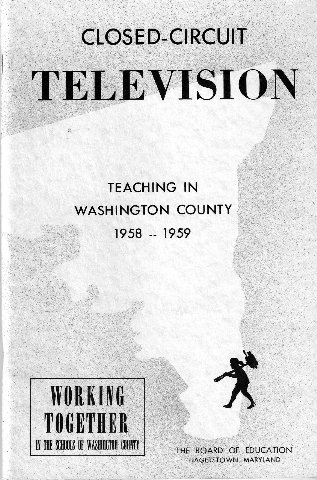 The
Board of Education first considered using television in the schools in 1954.
The Board was then aware that the children of the 1950's came to school with a
better background of information than earlier generations-and that a primary
reason for this was exposure to new experiences via television in the home. This
situation suggested a need for curriculum changes to avoid trying to teach
children things they already knew. It also suggested that television might be
even more valuable in the classroom than in the living room.
The
Board of Education first considered using television in the schools in 1954.
The Board was then aware that the children of the 1950's came to school with a
better background of information than earlier generations-and that a primary
reason for this was exposure to new experiences via television in the home. This
situation suggested a need for curriculum changes to avoid trying to teach
children things they already knew. It also suggested that television might be
even more valuable in the classroom than in the living room.
The
Board was unaware of it then, but a movement was underway to set up a project
which could explore the uses of television for instruction. Backing this project
was a joint committee formed by the Electronic Industries Association and the
Ford Foundation's Fund for the Advancement of Education, with a number of
consultants representing various educational agencies. The committee wanted to
start a large-scale project-something that would provide a comprehensive test of
television. The emphasis was to be on regular, direct instruction by television
rather than on occasional or supplemental uses of it.
Washington
County was ultimately chosen as the site of this project on the basis of a
proposal to use television for instruction at all grade levels and in basic
subject areas; to use it for teacher education and for improvement and
enrichment of the curriculum. The county also proposed to test television's
usefulness in relieving classroom and teacher shortages and in achieving better
use of community and school resources. And finally, it proposed to find out
whether instruction by television was economical.
This
study, the Washington County Closed-Circuit Educational Television Project, was
an exploratory and practical experience - not a formal research experiment. It
extended over a period of five years, 1956-1961, and included the schools of an
entire county school system. The project program developed as a natural
outgrowth of the curriculum improvement program which had been evolving over a
period of many years. Television lessons were scheduled regularly to make them
integral parts of courses, but at no grade level did they occupy a major portion of a school day. The telecasts did not prevent pupils from having
personal contacts with teachers and from engaging in the give and take of
classroom discussions. The television experience was planned as only part of a
total learning experience for the pupil.
The
project got underway in the summer of 1956. One hundred teachers,
principals, supervisors and community leaders gathered at a workshop in July
and August to plan the new television instruction program. At the same time a
team of Chesapeake and Potomac Telephone Company engineers under William C.
Warman began stringing cable for the television network; and John R. Brugger
left his post as chief radio and television engineer at the University of
Illinois to design and install the transmission center. The installation was
completed that fall in time for telecasting to eight schools. The system was
expanded until by September 1963, every public school in the county was linked
to the television circuit.
As
the project developed, television came steadily into use at all grade levels and
in most subject areas. Television instruction was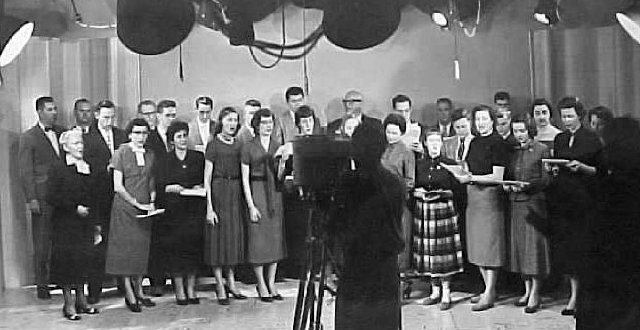 coordinated by staff
members T. Wilson Cahall and Robert F. Lesher. Each summer and at times during the school year, teachers, principals, parents, supervisors and
administrators gathered to assess progress and to restudy courses and teaching
methods. New courses were added, old ones altered -until today more than fifty
courses are included in the television program. By the time the project's
official life came to an end in 1961, the county not only had a new teaching aid
in the classroom, but also was well on the way toward having a vastly improved
curriculum and a new approach to teaching-by teams. The advantages of television
were apparent and the cost low enough so that after outside financing had ended,
the county was able to continue and even expand its use of television in the
classroom.
coordinated by staff
members T. Wilson Cahall and Robert F. Lesher. Each summer and at times during the school year, teachers, principals, parents, supervisors and
administrators gathered to assess progress and to restudy courses and teaching
methods. New courses were added, old ones altered -until today more than fifty
courses are included in the television program. By the time the project's
official life came to an end in 1961, the county not only had a new teaching aid
in the classroom, but also was well on the way toward having a vastly improved
curriculum and a new approach to teaching-by teams. The advantages of television
were apparent and the cost low enough so that after outside financing had ended,
the county was able to continue and even expand its use of television in the
classroom.
Throughout
the five years of the project, the county school system received support from
two major sponsors-the Electronic Industries Association and the Fund for the
Advancement of Education. Invaluable assistance also came from the Chesapeake
and Potomac Telephone Company of Maryland.
The
Electronic Industries Association, representing major electronics companies,
provided free of charge the necessary television cameras; receivers; and studio,
control room, projection and recording equipment. Seventy-five manufacturers
donated the equipment valued at $300,000.
The
Fund for the Advancement of Education and the Ford Foundation underwrote other
project expenses. These included the costs of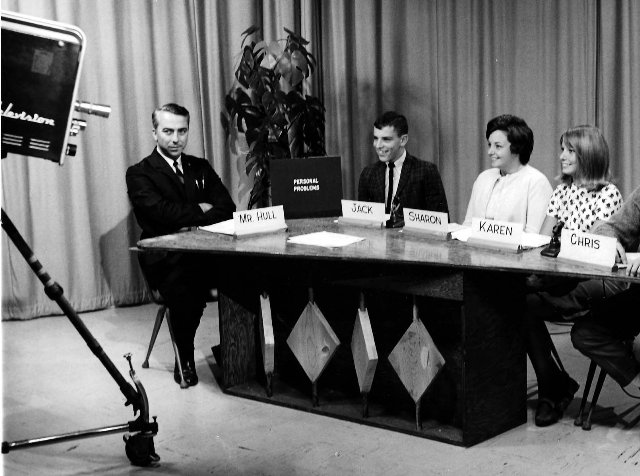 designing the system,
administering and supervising the project, providing secretarial help, paying
cable rental fees, securing additional television sets, solving various
production problems, training technical personnel, and carrying out the
evaluation program. The Fund and the Foundation together contributed about
$200,000 a year to the project over the five-year period.
designing the system,
administering and supervising the project, providing secretarial help, paying
cable rental fees, securing additional television sets, solving various
production problems, training technical personnel, and carrying out the
evaluation program. The Fund and the Foundation together contributed about
$200,000 a year to the project over the five-year period.
The
Chesapeake and Potomac Telephone Company, with technical advice from Bell
Laboratories, developed the closed-circuit system for transmitting television to
the classroom. This system included more than 115 miles of coaxial cable plus
transmitting and amplifying equipment.
THE
SYSTEM AND THE STAFF
To
many educators, the most unfamiliar and perhaps worrisome aspect of classroom
television is the system itself. It is a complex electronic affair, with strange
devices and odd terms like "videcon," "zoom" and
"dolly out." Yet the actual task of operating such a system is not as
forbidding as it might sound. Washington County has found that it can operate an
extensive closed-circuit system with a minimum of professional and technical
assistance. Many other school systems are probably in a position to do the same.
In
the completed system in Washington County, forty-five schools are linked by
coaxial cable to form a closed-circuit television network. Six lessons can be
sent simultaneously over this cable and picked up on more than 800 standard
twenty-one-inch television sets in classrooms, school cafeterias and
auditoriums throughout the county. Many classrooms are equipped with two sets,
so that no pupil has to sit far from the screen. Auditoriums and other large
viewing rooms are equipped with several sets, generally one for every
twenty-five children. Large screens are now being used to replace small
receiving sets in auditoriums and other large viewing areas
The
lessons are transmitted from a Television Center adjacent to the Board of
Education offices in Hagerstown. This center is a pre-fabricated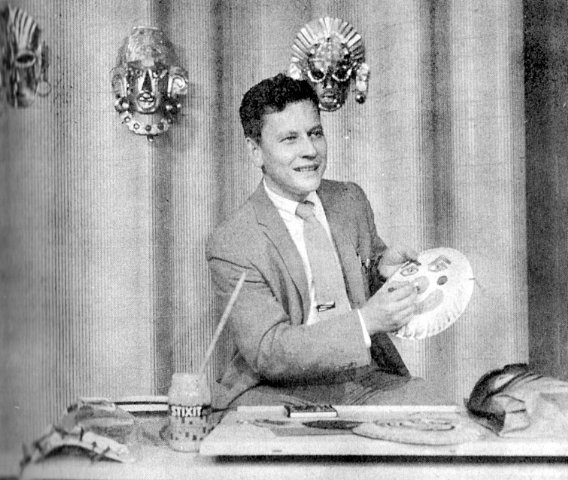 metal building
with a concrete block addition covering an area of 100 by 125 feet. A few years
ago it had a dirt floor and housed farm equipment. Now it contains five
television studios. Three of these are twenty-five by thirty feet, and two are
forty feet square-large enough to permit the use of an automobile or truck for
demonstrations. From these studios more than twenty-five lessons a day or 125
a week are transmitted to schools. These lessons are for the most part live
telecasts. The Columbia Broadcasting System, operating day and night seven
days a week, produces about 140 live programs, while National Broadcasting
Corporation in the same period transmits about sixty.
metal building
with a concrete block addition covering an area of 100 by 125 feet. A few years
ago it had a dirt floor and housed farm equipment. Now it contains five
television studios. Three of these are twenty-five by thirty feet, and two are
forty feet square-large enough to permit the use of an automobile or truck for
demonstrations. From these studios more than twenty-five lessons a day or 125
a week are transmitted to schools. These lessons are for the most part live
telecasts. The Columbia Broadcasting System, operating day and night seven
days a week, produces about 140 live programs, while National Broadcasting
Corporation in the same period transmits about sixty.
The
center also contains offices for production, engineering, supervisory and
clerical personnel, and a film projection room. Slides and films are stored,
repaired and previewed in the film room from which they can be fed either into
any of the five studios or directly to the schools over the closed-circuit
system. Adjacent to the Television Center is another pre-fabricated metal
building 100 by 40 feet, which contains office space for the studio teachers,
plus a workroom for the art staff.
Before
installing a television system for classroom instruction, it is first necessary
to
decide whether it shall be a closed- or open-circuit system. The open-circuit
system requires no cable, thus eliminating cable rental costs. But this system
provides a single transmission channel, so that only one lesson can be telecast
at a time. The closed-circuit system permits transmitting six or more lessons at
a time and since Washington County wanted to make extensive use of television
for teaching, it chose the closed circuit system.
At
the time the Board of Education asked the Chesapeake and Potomac Telephone
Company to install this system, in June of 1956, there was considerable question
as to whether it could be done economically. One engineer, for example, made a
guess that cable rental costs for such a system would amount to $2,500,000 a
year and capital costs to $7,000,000 or $8,000,000. His estimate made sense in
terms of costs then being experienced by the major networks; and there was no
other experience on which to base an estimate. No one had yet built an
economical closed-circuit system of the size and quality needed in Washington
County.
But
whereas the major networks transmit over a system combining expensive
underground cable and microwave relays, the Telephone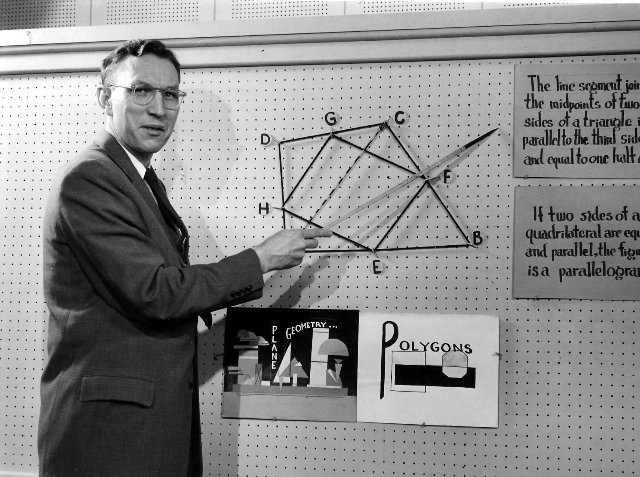 Company ultimately
worked out for Washington County a system using a simplified coaxial cable. The
cable rental cost is about $150,000 a year, or one-seventeenth of the
$2,500,000 estimate. This made all the difference between a practical and an
impractical system. The completed network, in fact, represented an electronic
engineering milestone, and systems built since have been modeled upon it. The
Telephone Company used its Washington County experience to formulate the rate
schedule that is now being used nationwide for its closed-circuit service.
Company ultimately
worked out for Washington County a system using a simplified coaxial cable. The
cable rental cost is about $150,000 a year, or one-seventeenth of the
$2,500,000 estimate. This made all the difference between a practical and an
impractical system. The completed network, in fact, represented an electronic
engineering milestone, and systems built since have been modeled upon it. The
Telephone Company used its Washington County experience to formulate the rate
schedule that is now being used nationwide for its closed-circuit service.
The
television network first reached 6,000 pupils in 1956, then 12,000 in 1957,
16,500 in 1958, 18,000 in 1961, and 20,500 in 1963. The quality of the system
has been improved steadily, and while it is not without flaw, it is highly
reliable and generally excellent. The chief engineer estimates the system's
reliability at better than 99%, which means that breakdowns are extremely
rare.
Operating
this system requires a substantial staff. A precise figure is hard to give
because there is no definite line between television personnel and
non-television personnel. In all, there are about seventy people working most
of the time in the television system-and this includes teachers, supervisors,
technical and clerical personnel, as follows:
-
Coordinator
1
-
-
Instructional
Supervisor 1
-
-
Teaching
Staff 25 (10 part-time)
-
-
Production
Staff 30 (17 part-time)
-
-
Engineering
Staff 8 (4 part-time)
-
-
Art
Staff 3
-
-
Clerical
Staff 4
A
brief discussion of the duties of the coordinator and of the supervisory,
production, engineering and art staffs follows. While these departments are
discussed separately, in practice they work together very closely. The
standard studio crew for telecasting a lesson includes the teacher, two
technicians, a director, a floor manager and two cameramen. All are
interdependent.
COORDINATOR
The
coordinator works directly under the assistant superintendent in charge of
instruction as chief-of-staff for television. His duties induced coordination
of the work of the departments of engineering, production and instruction.
INSTRUCTIONAL
SUPERVISORY STAFF
A
supervisor of television instruction works as a member of the county staff of
general instructional supervisors. His responsibilities to the studio faculty
are similar to those of a principal in a conventional school. The entire group
of instructional supervisors, however, provides assistance to studio teachers in
the planning, teaching and evaluating of televised courses.
studio faculty
are similar to those of a principal in a conventional school. The entire group
of instructional supervisors, however, provides assistance to studio teachers in
the planning, teaching and evaluating of televised courses.
In
addition to their other relationships with studio teachers, instructional
supervisors arrange for them to meet with classroom teachers to discuss problems
of mutual concern as members of a teaching team.
PRODUCTION
STAFF
It
is the teacher's responsibility to present the lesson and the engineer's job
to transmit it, while it is the production staff's job to see that the lesson is
presented as effectively as possible. The task of the production staff is not
easily defined. The teacher is, essentially, the equivalent of the commercial
station's producer. He decides what his lesson is to include, and no techniques
of production are allowed to violate the teacher's conception of the method
and principles of teaching involved. The director is there to help the teacher
work effectively -to help him use television's many capabilities. Production
techniques are designed to implement the teacher's conception of the lesson.
The
teacher new to television has much to learn about teaching in a studio
situation. He must modify his habits of walking and talking. He must learn
the skills of interviewing, working with a studio crew, using studio cues and
signals and teaching with a variety of visual aids. This does not imply that the
television teacher must become a professional actor. It means mastering simple
techniques such as walking slowly enough for the camera to follow smoothly, and
gesturing in such a way that the camera does not distort the arm or hand. The
teacher must also learn how to prepare a script outline. The script is necessary
not only as a guide for the teacher but also as a cue to let the director know
what the teacher plans to do, and when. If the teacher intends to walk from one
part of the studio to another, the director must know when, so that he can have
the cameras in readiness. If films, slides or other kinds of visual aids are to
be used, the script must indicate to the director when and where in the sequence
of the lesson they are to come.
At
the Television Center, two experienced supervisors head the production staff.
They also teach communications courses for the Hagerstown Junior College. Most
of their staff of thirty is made up of junior college students, about half of
whom are majoring in communications. In addition to the two supervisors, there
are five full-time and three part-time directors. The rest of the staff is made
up of cameramen and floor managers who assist the director. The fact that many
of the students are studying communications at the junior college is a great
advantage in training them for work at the Television Center.
About
half of the production crewmen are new at the beginning of each school year.
Many of them arrive at the Television Center less than two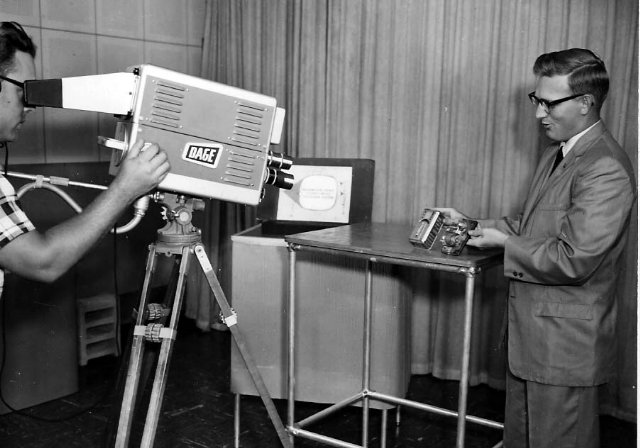 weeks before school
opens, knowing only how to operate the family television set. In twelve days
they are operating cameras with considerable skill. Ninety per cent of the
television lessons are live. The rest are taped on occasions when the teacher
must be absent at the usual lesson time, wishes to interview a resource person
at his convenience or desires to evaluate his telecast as it is received in a
classroom situation.
weeks before school
opens, knowing only how to operate the family television set. In twelve days
they are operating cameras with considerable skill. Ninety per cent of the
television lessons are live. The rest are taped on occasions when the teacher
must be absent at the usual lesson time, wishes to interview a resource person
at his convenience or desires to evaluate his telecast as it is received in a
classroom situation.
ENGINEERING
STAFF
The
Chesapeake and Potomac Telephone Company carries all responsibility for the
maintenance and operation of the cable and the system amplifying equipment.
All other equipment-television cameras, receivers, projection, recording, studio
and control room equipment-is the responsibility of the chief engineer and his
assistants. They maintain equipment and supervise the transmission of the
audio and video signals.
The
engineer and his assistant supervise the staff of technicians who have varied
responsibilities.
The
Engineering Department, like the Production Department, trains its own
personnel. With the exception of the chief engineer and his assistant, all are
junior college students or recent high school graduates. Not infrequently these
students go on to careers in electronics.
1.
The film room operator
-
maintains
a library of films which he catalogues, deans, splices, and inspects.
-
feeds
the proper film into the studio, or directly to the schools.
-
schedules
film previews for teachers and helps teachers select parts of a film for use
in their lessons.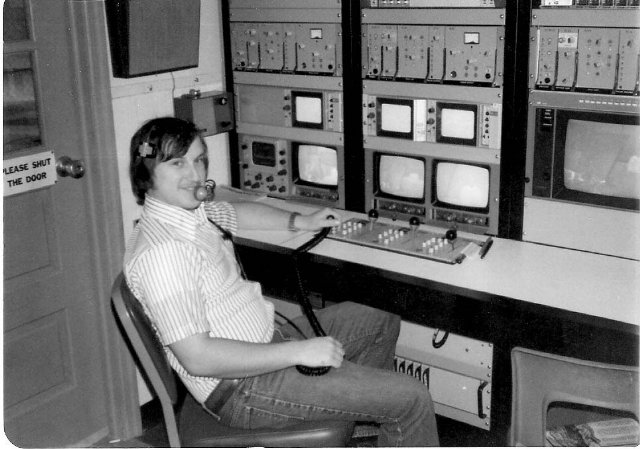
2.
The video-tape recorder technician
-
records
lessons or special demonstrations
-
maintains
a library of approximately 200 one-hour tapes of previously recorded
materials
-
operates
the video-tape recorder
-
schedules
the replaying of topes
3.
The audio-video operators
-
connect
the studio to the proper channel
-
control
the equipment which determines the quality of the audio and video signal
-
operate
turn tables and recorders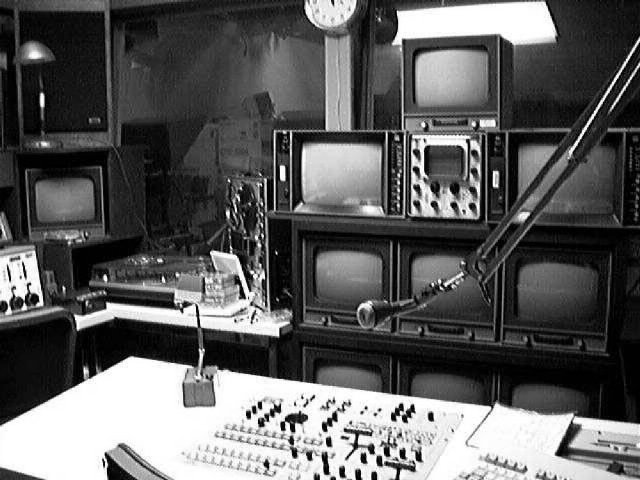
4.
The maintenance crewmen
-
service
the 800 television sets located in 45 schools
-
test
the 15,000 tubes in the television system
-
install
and maintain equipment at the Television Center
ART
STAFF
The
Art Department provides a number of important services. There are three
full-time staff members in this department, all recent high school graduates
talented in art. They prepare most of the maps, charts, diagrams, acetate
overlays, special illustrations, models, and backgrounds for sets and similar
material used by the teachers in more than fifty televised courses. While much
commercially-produced illustrative material is available; often it is not
suitable for television. Many maps are too detailed, and illustrations are not
proportioned for the television screen, which requires a height /width ratio
of three to four. Worthwhile illustrative material can often be produced much
more cheaply than it can be purchased. Having the Art Department makes it
possible for teachers to be much more flexible in planning graphic materials
for their lessons-a vital advantage if the most effective use is to be made of
television.
TELEVISION
IN THE SCHOOLS
The
"correct" way to fit television into the conventional school routine
will probably be debated for years to come. The proper length of the television lesson, the optimum size for the television class opinions about
these and other problems may ultimately fill volumes. No one now has had enough
experience to know the best conclusions.
television lesson, the optimum size for the television class opinions about
these and other problems may ultimately fill volumes. No one now has had enough
experience to know the best conclusions.
Nevertheless,
a few things do seem clear. One is that television should not take up a major
portion of any pupil's school day; television is best used as a specialized kind
of learning experience or as an aid to classroom instruction. The other is that
a television lesson should generally be followed as soon as possible by a
session with the classroom teacher.
But
there is now no easy answer to the question of how long a television lesson
should be. The fact that the attention span of a first grader is shorter than
that of a high school pupil has bearing on the question. So does the fact that
pupils at the same grade level can profit by a longer television lesson in a
subject like art, than in others, such as conversational French, where more
concentration is required.
At
present elementary pupils spend 7.3 % to 13 % of their classroom time watching
television lessons. These lessons, ranging in length from thirteen to
twenty-five minutes, are followed by work in the subject with the classroom
teacher. Junior high school pupils spend almost one-third of their time in
television classes, while high school pupils seldom spend more than 10% of
their time in television classes.
None
of these time periods are recommended as the ideal. The staff is inclined to
believe that the amount of television viewing time in the elementary schools is
satisfactory. Junior high schools may have too much viewing time, while high
school pupils might profitably spend more time than they now do.

The
flexibility of the elementary school day makes it much easier to use
television there than in the junior or senior high school. Since there are no
rigidly defined periods in the elementary school, the classroom teacher can
devote as much or as little time as he deems necessary to preparation for the
television lesson, or to discussion and other follow-up work. The junior and
senior high school schedules, on the other hand, are relatively inflexible.
When the day is made up of six periods of equal length, both television and
classroom teachers are more limited in what they can do.
In
certain subjects, television is obviously very successful. In others, it is less
so, although it appears that in no subject does television fail to produce
results at least as good as those achieved when classroom instruction alone is
used. There are many on the county staff now who believe that any well taught
subject will be effective on television, and that failures are caused by
unsatisfactory presentation, not by weaknesses inherent in television. It is
certainly true that no one should judge hastily whether or not a course is
suitable for television. Many teachers in Washington County who thought that
arithmetic could not be taught successfully on television have changed their
minds, because test results have made it quite clear that elementary pupils made
much more rapid progress in arithmetic with television than they did without it.
TEACHERS
AND TELEVISION
The
impact of television on the Washington County school system has been far
greater than anyone could have predicted in 1956. Nowhere has this impact been
more obvious than in the area of teaching and teaching methods.
Television
has made the talents of some' of the county's teachers far more widely available
than they were before. This benefits not only the pupils, but also many other
teachers who, for the first time, have an opportunity to watch their colleagues
at work. When this first happened, teachers with thirty years' experience
sometimes discovered, often to their surprise, that there were quite a few
teaching techniques they had not known about. Before television, these teachers
had to depend largely on theory and experience to guide them. Now they have a
daily opportunity to watch and weigh the methods and theories of others, and to
see how these work out in practice. For most teachers, this has been an
enlightening experience. It has provided on-the-job training never before
possible.
An
even more notable change brought by television has been the establishment of
teaching teams. The teacher in the studio and the teachers in the classroom
comprise the team.
Undoubtedly,
Television has a place in the instructional program of the school.Television
adds a new dimension to the instructional program. Through the use of visuals
and other techniques unique to television, classroom television provides
experiences for Washington County pupils that could not be achieved in other
ways.
 The
Board of Education first considered using television in the schools in 1954.
The Board was then aware that the children of the 1950's came to school with a
better background of information than earlier generations-and that a primary
reason for this was exposure to new experiences via television in the home. This
situation suggested a need for curriculum changes to avoid trying to teach
children things they already knew. It also suggested that television might be
even more valuable in the classroom than in the living room.
The
Board of Education first considered using television in the schools in 1954.
The Board was then aware that the children of the 1950's came to school with a
better background of information than earlier generations-and that a primary
reason for this was exposure to new experiences via television in the home. This
situation suggested a need for curriculum changes to avoid trying to teach
children things they already knew. It also suggested that television might be
even more valuable in the classroom than in the living room. coordinated by staff
members T. Wilson Cahall and Robert F. Lesher. Each summer and at times during the school year, teachers, principals, parents, supervisors and
administrators gathered to assess progress and to restudy courses and teaching
methods. New courses were added, old ones altered -until today more than fifty
courses are included in the television program. By the time the project's
official life came to an end in 1961, the county not only had a new teaching aid
in the classroom, but also was well on the way toward having a vastly improved
curriculum and a new approach to teaching-by teams. The advantages of television
were apparent and the cost low enough so that after outside financing had ended,
the county was able to continue and even expand its use of television in the
classroom.
coordinated by staff
members T. Wilson Cahall and Robert F. Lesher. Each summer and at times during the school year, teachers, principals, parents, supervisors and
administrators gathered to assess progress and to restudy courses and teaching
methods. New courses were added, old ones altered -until today more than fifty
courses are included in the television program. By the time the project's
official life came to an end in 1961, the county not only had a new teaching aid
in the classroom, but also was well on the way toward having a vastly improved
curriculum and a new approach to teaching-by teams. The advantages of television
were apparent and the cost low enough so that after outside financing had ended,
the county was able to continue and even expand its use of television in the
classroom. designing the system,
administering and supervising the project, providing secretarial help, paying
cable rental fees, securing additional television sets, solving various
production problems, training technical personnel, and carrying out the
evaluation program. The Fund and the Foundation together contributed about
$200,000 a year to the project over the five-year period.
designing the system,
administering and supervising the project, providing secretarial help, paying
cable rental fees, securing additional television sets, solving various
production problems, training technical personnel, and carrying out the
evaluation program. The Fund and the Foundation together contributed about
$200,000 a year to the project over the five-year period. metal building
with a concrete block addition covering an area of 100 by 125 feet. A few years
ago it had a dirt floor and housed farm equipment. Now it contains five
television studios. Three of these are twenty-five by thirty feet, and two are
forty feet square-large enough to permit the use of an automobile or truck for
demonstrations. From these studios more than twenty-five lessons a day or 125
a week are transmitted to schools. These lessons are for the most part live
telecasts. The Columbia Broadcasting System, operating day and night seven
days a week, produces about 140 live programs, while National Broadcasting
Corporation in the same period transmits about sixty.
metal building
with a concrete block addition covering an area of 100 by 125 feet. A few years
ago it had a dirt floor and housed farm equipment. Now it contains five
television studios. Three of these are twenty-five by thirty feet, and two are
forty feet square-large enough to permit the use of an automobile or truck for
demonstrations. From these studios more than twenty-five lessons a day or 125
a week are transmitted to schools. These lessons are for the most part live
telecasts. The Columbia Broadcasting System, operating day and night seven
days a week, produces about 140 live programs, while National Broadcasting
Corporation in the same period transmits about sixty. Company ultimately
worked out for Washington County a system using a simplified coaxial cable. The
cable rental cost is about $150,000 a year, or one-seventeenth of the
$2,500,000 estimate. This made all the difference between a practical and an
impractical system. The completed network, in fact, represented an electronic
engineering milestone, and systems built since have been modeled upon it. The
Telephone Company used its Washington County experience to formulate the rate
schedule that is now being used nationwide for its closed-circuit service.
Company ultimately
worked out for Washington County a system using a simplified coaxial cable. The
cable rental cost is about $150,000 a year, or one-seventeenth of the
$2,500,000 estimate. This made all the difference between a practical and an
impractical system. The completed network, in fact, represented an electronic
engineering milestone, and systems built since have been modeled upon it. The
Telephone Company used its Washington County experience to formulate the rate
schedule that is now being used nationwide for its closed-circuit service.
 studio faculty
are similar to those of a principal in a conventional school. The entire group
of instructional supervisors, however, provides assistance to studio teachers in
the planning, teaching and evaluating of televised courses.
studio faculty
are similar to those of a principal in a conventional school. The entire group
of instructional supervisors, however, provides assistance to studio teachers in
the planning, teaching and evaluating of televised courses. weeks before school
opens, knowing only how to operate the family television set. In twelve days
they are operating cameras with considerable skill. Ninety per cent of the
television lessons are live. The rest are taped on occasions when the teacher
must be absent at the usual lesson time, wishes to interview a resource person
at his convenience or desires to evaluate his telecast as it is received in a
classroom situation.
weeks before school
opens, knowing only how to operate the family television set. In twelve days
they are operating cameras with considerable skill. Ninety per cent of the
television lessons are live. The rest are taped on occasions when the teacher
must be absent at the usual lesson time, wishes to interview a resource person
at his convenience or desires to evaluate his telecast as it is received in a
classroom situation.

 television lesson, the optimum size for the television class opinions about
these and other problems may ultimately fill volumes. No one now has had enough
experience to know the best conclusions.
television lesson, the optimum size for the television class opinions about
these and other problems may ultimately fill volumes. No one now has had enough
experience to know the best conclusions.